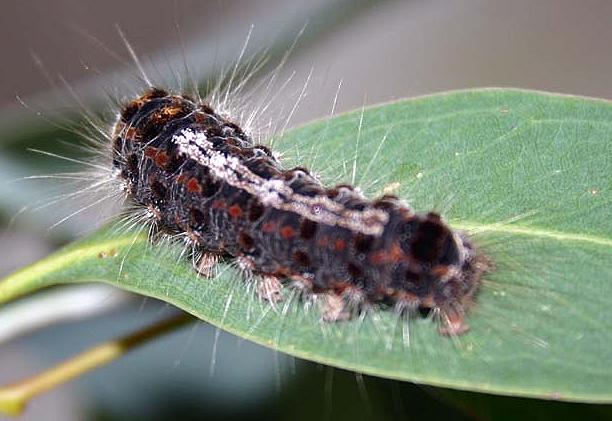
| Mistletoe Brown-Tail Moth (also known as Urocoma edwardsi) LYMANTRIINAE, EREBIDAE, NOCTUOIDEA | (donherbisonevans@yahoo.com) and Stella Crossley |

(Photo: courtesy of
Harold McQueen, Goodna, Queensland)

| Mistletoe Brown-Tail Moth (also known as Urocoma edwardsi) LYMANTRIINAE, EREBIDAE, NOCTUOIDEA | (donherbisonevans@yahoo.com) and Stella Crossley |

(Photo: courtesy of
Harold McQueen, Goodna, Queensland)
The Caterpillars of this species are dark grey, with a row of dark red spots along each side of the back, and with white patches on the backs of the middle five abdominal segments. The caterpillars have white lateral hairs along each side. The head is black with a narrow white collar. The thorax has brown dorsal markings. There is a black hairy knob on the back of the last abdominal segment. The penultimate pair of abdominal segments each have a pink or red dorsal gland.

The caterpillars feed on various Mistletoes (LORANTHACEAE) including:
When the larvae run out of food, they wander off, often invading dwellings. This is not good, as the hairs on this caterpillar cause Urticaria and Dendrolimiasis in sensitive individuals.

Just killing the caterpillars in situ is hazardous as the hairs from the dead larvae can blow about and cause more inflammation. If you or people in your family are sensitive, you will have to be vigilant and collect any larvae that you see with forceps or long-nosed pliers into say a jam-jar which can be closed for transport a long way away.
Even burning the caterpillars is hazardous as the hairs can be released and fly about in the updrafts. This is only a good idea if first the caterpillars are doused in an inflammable fluid, to ensure that the hairs burn first.
The hairs from dead caterpillar skins, discarded naturally by the caterpillars when they moult, can blow over wide areas. Trying to collect the hairs with a vacuum cleaner is unwise as vacuum cleaners must blow as well as suck, and the blowing exacerbates the problem. One laborious but safe method of removing such loose hairs is with say long strips of wide sticky tape, holding the ends in each hand, and dabbing the tape onto surfaces with hairs on them.
If you have been affected by the hairs: anti-histamine pills might help. You could also try putting acid (like vinegar) and alkali (like washing soda) on the affected areas to see if they help, as they do with jellyfish stings. The hairs of the caterpillars carry random bacteria which are effectively injected under the skin by the sharp points of the hairs, so rubbing hand-sanitizer on the areas may help too.
The caterpillar pupates in a yellow cocoon in the ground leaf litter.

The adult female moth is a variable pale orange-brown, sometimes with a faint pale spot near the middle, and a pale area along the margin of each forewing. The moth has prominent pair of black eyes, brown or ginger hairs around the head, and a dark abdomen with a compact yellow tuft on the tip. The female moths have a wingspan of up to 5 cms.

The male moths are similar but smaller, with a wingspan of about 4 cms. The males have a looser tail tuft, and more feathery antennae, than the females.

The species has been in Australia in:

The species has, over the years, been placed by various taxonomists in a variety of genera, including Euproctis, Nygmia, Teara, and Urocoma.

Further reading :
David Carter,
Butterflies and Moths,
Collins Eyewitness Handbooks, Sydney 1992, p. 269.
Ian F.B. Common,
Moths of Australia,
Melbourne University Press, 1990, fig. 55.4, pl. 19.13, pp. 69, 429.
Peter B. McQuillan, Jan A. Forrest, David Keane, & Roger Grund,
Caterpillars, moths, and their plants of Southern Australia,
Butterfly Conservation South Australia Inc., Adelaide (2019), p. 150.
Peter Marriott,
Moths of Victoria: part 2,
Tiger Moths and their Allies - Noctuoidea (A),
Entomological Society of Victoria, 2009, pp. 16-19.
Edward Newman,
Characters of a few Australian Lepidoptera, Collected by Mr. Thomas R. Oxley,
Transactions of the Entomological Society of London,
New Series, Volume III, Number 8 (1856), pp. 284-285, and also
Plate 18, fig. 10.
Paul Zborowski and Ted Edwards,
A Guide to Australian Moths,
CSIRO Publishing, 2007, pp. 176, 179.
 caterpillar |  butterflies |  Lepidoptera |  moths |  caterpillar |
(updated 13 November 2010, 23 September 2022)